Rock is the hard mineral substance that forms the solid part of Earth’s crust. Mountains and canyons expose many different types of rock on their surfaces. Great cliffs of rock line the seashore in such places as Maine, California, and southern England. In many desert regions, rock formations rise above sandy plains. In most fairly flat areas, a layer of soil covers the underlying rock. Soil consists of tiny fragments of rock and grains of minerals mixed with decaying remains of plants and animals. Stones and pebbles are pieces of rock, and gravel consists of loose, rounded rock fragments.
Most rocks are aggregates. Aggregates contain crystals or grains of two or more different minerals. Much granite, for example, contains grains of clear quartz, pinkish potassium feldspar, white plagioclase, and black biotite or hornblende. Some rocks have grains so small that they can be seen only when a thin slice of the rock is examined under a microscope. A few kinds of rock consist almost entirely of only one mineral. Quartzite, for example, is rock composed of the mineral quartz, and limestone is rock composed of the mineral calcite.
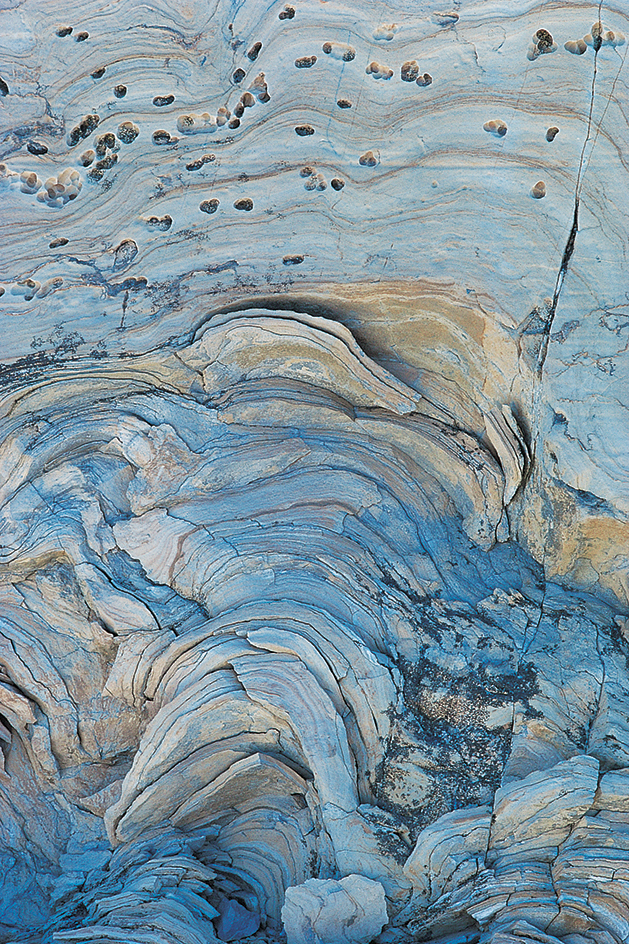
People use rocks in many ways. Builders use granite, marble, and other rocks as construction materials. Cement is made from finely crushed and heated limestone. Sand and gravel or crushed stone mixed with wet cement makes strong, durable concrete, an artificial rock, for use in buildings, highways, and dams.
Such metals as aluminum, copper, iron, lead, tin, and zinc come from rocks called ores. Ores also supply radioactive metals, such as uranium, and nonmetallic minerals, such as borax, graphite, and trona. In Minnesota and western Australia, deposits of iron ore make up entire mountains. In tropical climates, weathering (the breaking down of rock) creates thick soils rich in the aluminum-bearing ore bauxite.
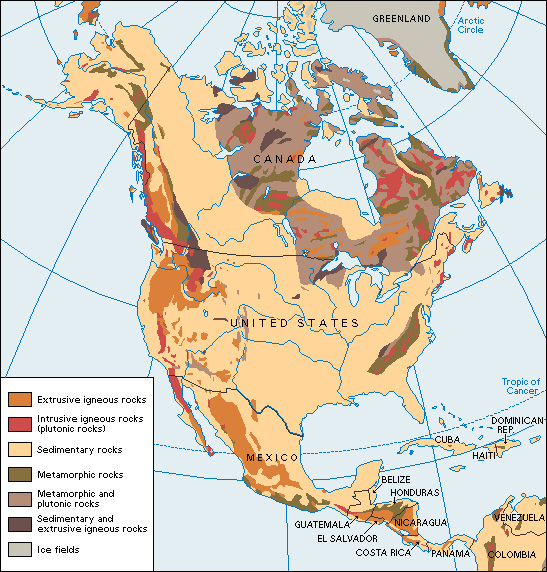
Some rocks hold valuable crystals. In Africa and Australia, workers mine diamonds from a rock called kimberlite. Beautiful green emeralds come from rocks in Colombia, India, Russia, and South Africa. Most blue aquamarine comes from Brazil and Madagascar. Emerald and aquamarine are gem forms of the mineral beryl.
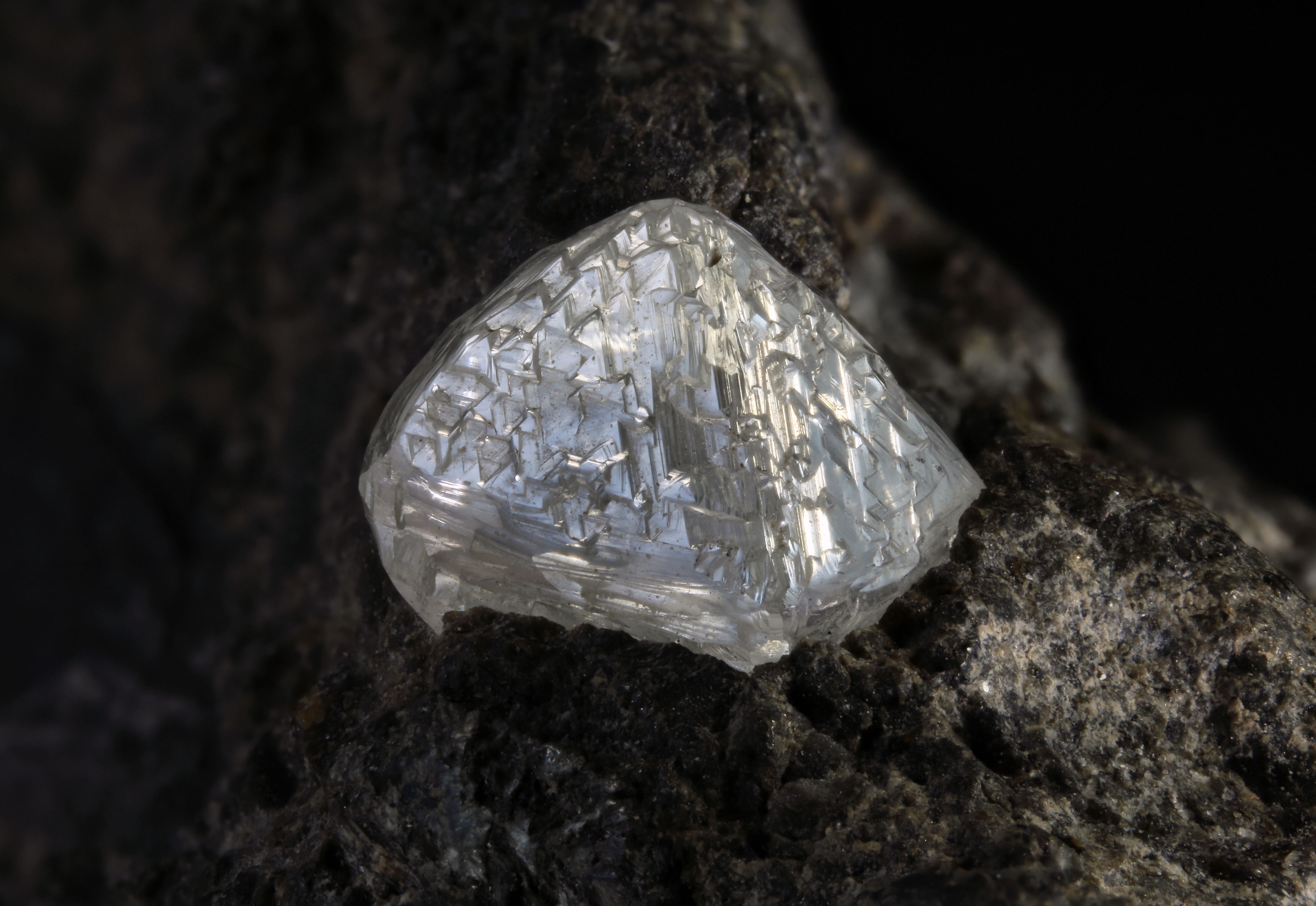
Geologists study rocks to trace Earth’s history (see Geology). Petroleum geologists analyze the age, structure, and composition of rock layers to find petroleum deposits. Paleontologists study fossils found in rock to learn about living things that existed millions of years ago (see Fossil).
Thousands of young people and adults collect rocks and minerals as a hobby. They trade rocks just as stamp collectors trade stamps. There are thousands of rock and mineral clubs throughout the world. These clubs hold regular meetings, sponsor study groups and museum exhibits, and organize field trips to collecting areas.
Geologists divide rock into three different classes: (1) igneous rock, (2) sedimentary rock, and (3) metamorphic rock. Igneous rock forms when molten rock cools. Sedimentary rock forms from loose deposits of rocky material. Metamorphic rock is created when other rocks are changed by heat and pressure.
Igneous rock
Igneous rock forms from magma (molten rock). Magma is extremely hot, with temperatures ranging from 1400 to 2300 °F (760 to 1300 °C). Most magma lies deep below Earth’s surface. Sometimes, magma rises to the surface through fissures (deep cracks) in Earth’s crust. Other times, magma travels up conduits (pipelike channels in the rock) and erupts at the surface, forming a volcano. Magma cools and hardens into igneous rock. Geologists divide igneous rock into two types: extrusive rock, which forms when magma flows onto the surface, and intrusive rock, which forms when magma hardens beneath the ground.

Extrusive rock
(also known as volcanic rock) forms from magma that reaches Earth’s surface. The magma emerges as streams of hot lava or as fine cinders and ash. Volcanoes are piles of lava, cinder, and ash that have accumulated over tens, hundreds, or even millions of years.
Magma hardens quickly when exposed to the cooler temperatures on the surface, leaving little time for minerals to crystallize (develop crystals). As a result, most extrusive rocks have small grains. In some cases, magma cools so quickly that it forms obsidian, a smooth, shiny volcanic glass with few crystals. Often, gas dissolved in the magma bubbles out as the magma cools. The gas bubbles leave cavities in the rock. Geologists call volcanic rock with many round or oval-shaped cavities cinder. Magmas rich in dissolved gases can form pumice, a rock filled with so many tiny cavities that some pieces can float on water. Lava that hardens more slowly forms rocks composed entirely of crystals.
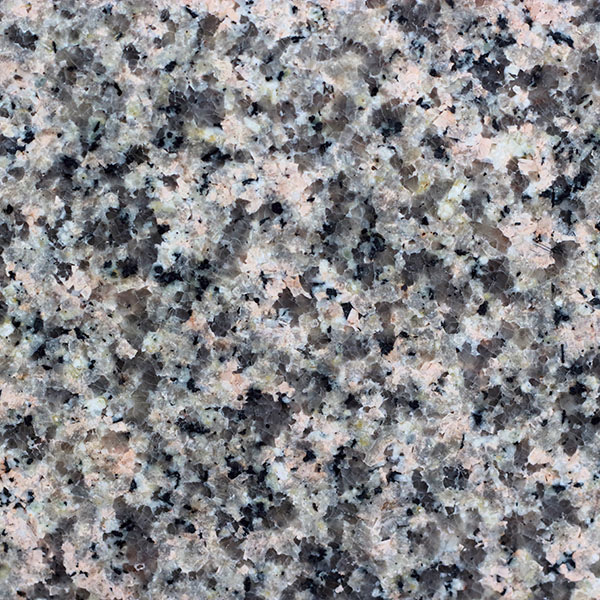
Dark-colored igneous rocks called basalts result from magmas that contain little dissolved gas and erupt rather slowly. Light-colored igneous rocks called andesites commonly form from magmas that contain large amounts of dissolved gas and erupt with explosive violence. Explosive eruptions produce rock fragments ranging from tiny particles of volcanic dust to lumps called volcanic bombs that measure 3 feet (1 meter) or more in diameter. Rocks called volcanic breccias consist of fragments of cooling magma that become welded together.
Intrusive rocks
(also known as plutonic rocks) form from magma that does not rise all the way to Earth’s surface. Instead, it pushes into older rock formations and hardens into structures called intrusions. Intrusions that cut across older rock layers are called dikes. Sills are intrusions that spread out between older rock layers, forming a parallel layer. Some sills, called laccoliths, push the rock layers above them into a domelike formation. Magma can melt older rocks and pass through them, creating huge intrusions called batholiths and smaller intrusions called stocks.
Beneath the surface, magma cools and hardens slowly. As a result, most intrusive rocks have crystal grains large enough to be seen with the unaided eye. Intrusive rocks include dark-colored gabbros and light-colored diorites and granites. In some places, the last pockets of slowly crystallizing magma are rich in rare elements and form giant crystal grains. These rocks, known as pegmatites, may contain beautiful crystals of tourmaline, beryl, spodumene, and other unusual minerals.
Sedimentary rock
Sedimentary rock forms from loose pieces of rock and minerals called sediments. Sediments accumulate in layers called strata. Strata can also trap plant and animal remains within them. As more strata are deposited, the sediments harden into solid rock. Most sedimentary rock forms on the ocean floor, but some develops on land and in fresh water. Geologists classify sedimentary rocks according to the type of sediments that formed them. These include (1) clastic sediments, (2) chemical sediments, and (3) organic sediments.

Clastic sediments
are rock fragments that range in size from large boulders and stones, through pebbles and gravel, to grains of sand and particles of silt (fine dirt) and clay. Air, water, and frost create these sediments by weathering rock, breaking it into fragments.
Clastic sediments can be carried about and deposited, chiefly by running water, but sometimes by wind or glaciers. As the sediments accumulate, the weight of the upper strata compacts the sediments below, squeezing the water from them. These lower sediments turn to rock through a process called lithification. In lithification, natural chemical substances left behind by groundwater cement the grains together. Deposits of silt lithify to form the rock siltstone, and layers of clay lithify to form shale. Sandstones form from layers of sand. Conglomerates form where layers of water-worn boulders, stones, and pebbles become cemented together. Sedimentary breccias form from angular pieces of rock that have not been moved far and rounded by flowing water.
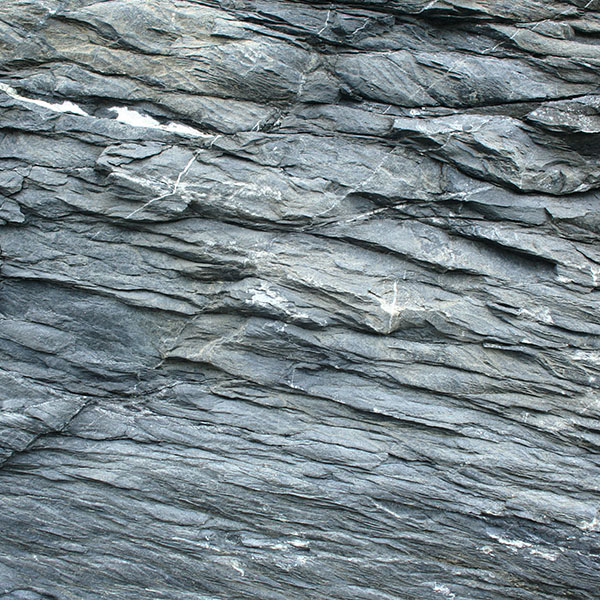
Chemical sediments
are minerals that dissolve in water. When the water evaporates, the minerals crystallize, leaving deposits of such minerals as rock salt (sodium chloride), phosphate rock (calcium phosphate), and gypsum (calcium sulfate). Many limestone deposits formed from crystals of calcite (calcium carbonate), and most large iron ore deposits crystallized from iron oxide once dissolved in ancient oceans.
Organic sediments
are the shells, skeletons, and other parts of once-living things. Shellfish take calcite from water and use it to build their shells. Corals use the same mineral to build coral reefs (see Coral). Deposits of coral and shells can lithify to form fossiliferous limestone.
Rock can also form from the accumulation of skeletons of single-celled sea creatures, such as foraminifera, diatoms, and radiolaria. The calcite shells of foraminifera form chalky limestone, such as that which makes up the famous white cliffs of Dover, England. Diatom shells, made of the mineral silica, form diatomite. The silica skeletons of radiolaria form beds of a rock called radiolarian chert in the deep ocean.
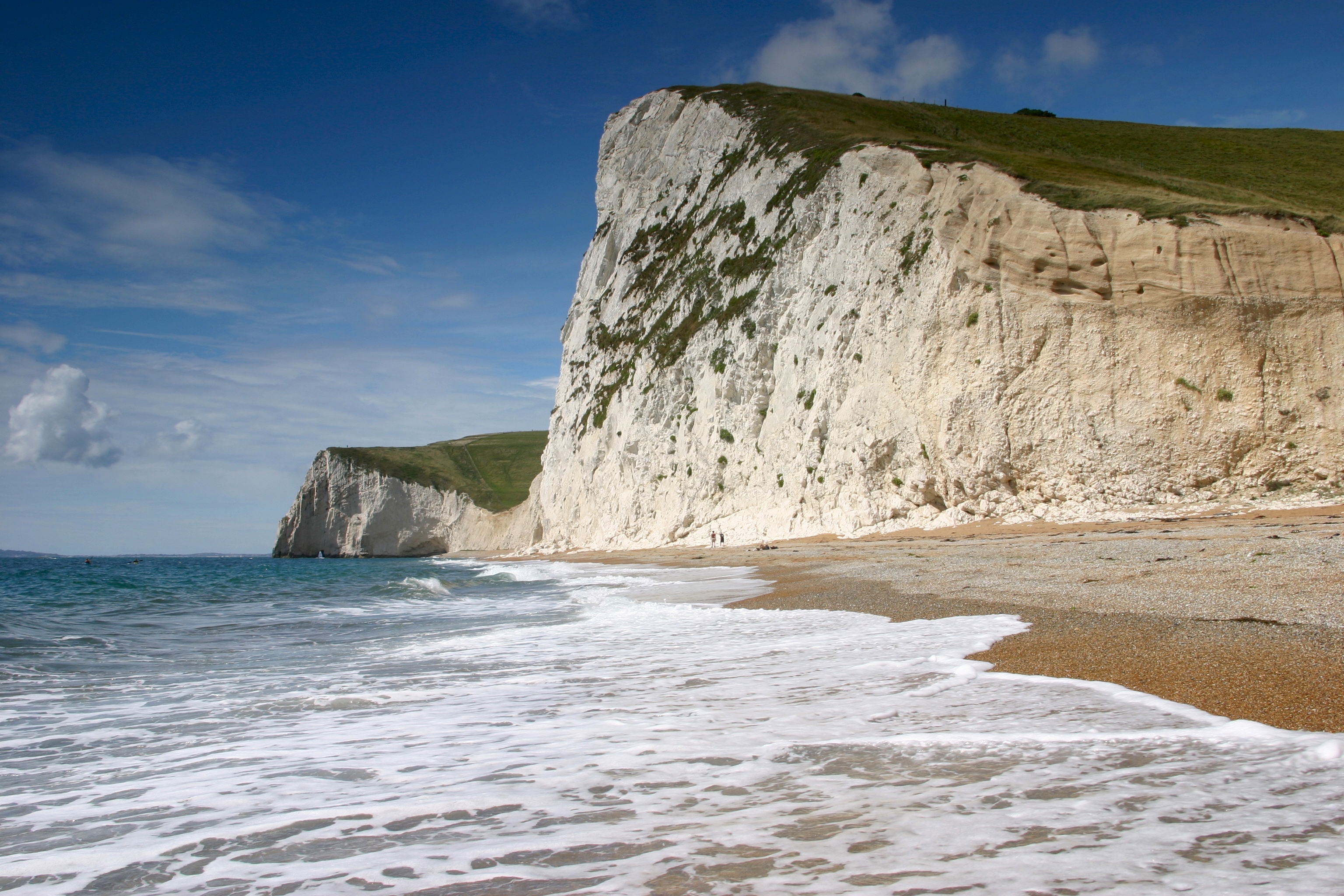
Coal develops from thick accumulations of dead plant matter in tropical swamps. These deposits compact into a decayed plant material called peat. As the peat becomes buried, pressure and heat turn it into coal (see Coal (How coal was formed)).
Metamorphic rock
Metamorphic rock forms when a rock’s appearance—and, in most cases, its mineral composition—changes. Geologists call this process of change metamorphism.
Metamorphism often takes place when heat and pressure increase as rock becomes more deeply buried. The intrusion of magma can heat nearby rock, causing contact metamorphism. The forces that create mountains not only produce heat and pressure but also deform the rocks. Metamorphism and deformation turn granite into gneiss, a metamorphic rock with wavy bands of feldspar, quartz, and mica crystals. Metamorphism can cause the calcite in limestone to recrystallize, forming marble. The grains in quartz-rich sandstone can grow together to form quartzite. Shales harden to form slate, a rock that splits into smooth slabs. At higher temperatures, shales and siltstones turn into schists that glisten with mica and other minerals, such as hornblende and chlorite. Some minerals, such as andalusite, kyanite, sillimanite, and staurolite, only form during metamorphism.
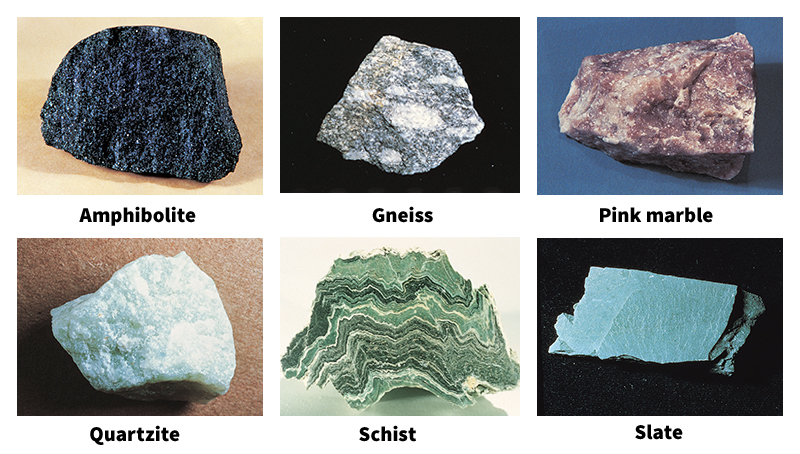
The rock cycle
Each type of rock develops from other types of rock. To help explain how rocks form, geologists sometimes refer to a series of transformations called the rock cycle. The rock cycle begins with igneous rock created by magma flowing to Earth’s surface. Weathering alters the rock chemically and breaks it into particles. The particles accumulate and harden to form sedimentary rock. As the sedimentary rock becomes buried, heat and pressure transform it into metamorphic rock. With enough heating, metamorphic rocks melt into magma that can form igneous rock, completing the cycle.
Rock rarely proceeds through the entire rock cycle. The cycle may be halted, or steps can be skipped, repeated, or reversed. For example, some igneous rocks transform directly into metamorphic rock, and sedimentary rock can weather and then lithify to form other kinds of sedimentary rock.
Rocks as a hobby
You can find interesting rocks in many places near your home. Good “hunting grounds” include mines, quarries, building excavations, ocean cliffs and beaches, and the rocky sides of road cuts and riverbanks. Be careful when working near steep rock walls, roadways, deep holes, and other dangerous areas. Always obtain permission to visit private property.
Tools.
You can start a collection by gathering loose rocks, but a few simple tools will help in obtaining good specimens. A rock hammer, the most important tool, has a square head and a pointed end for breaking specimens from the surrounding rock. A chisel helps loosen crystals. Some rock hunters use a magnifying glass in choosing desirable specimens. Scratching a specimen across a piece of unglazed porcelain called a streak plate can help rock collectors recognize minerals. A pocketknife makes a handy tool for testing mineral hardness. You can buy all these tools inexpensively from a hardware store or mineral dealer and carry them in a small backpack. You can wrap specimens in newspaper or tissue paper to protect them.
As you collect, label each specimen with the location and date of collection and the kind of rock or mineral it may be. Later, you can transfer this information to a permanent record book or computer file.
Identifying rocks.
You can identify a specimen by comparing it to pictures in a reference book or rock samples from a reference collection. A useful reference book for identifying rocks should feature good color photographs. You can purchase small reference collections of rocks and mineral specimens inexpensively from a rock or mineral dealer.
All minerals have special characteristics that can help you identify them. Experienced collectors also study the formations in which rocks are found.
Chemical composition
may be determined by certain chemical tests for the mineral elements. For example, a simple chemical test for calcite in limestone is to pour warm soft drink over the rock. The soft drink, a weak acid, fizzes vigorously on limestone.
Hardness
is a measure of how easy it is to scratch a mineral. You can scratch soft minerals with your fingernail. Harder minerals are scratched by a steel knife blade or pin. The hardest minerals resist scratching by all materials except diamond—the hardest mineral known.
Streak color
is the color of the powder obtained by rubbing a mineral across a streak plate. The powder color often differs from the color of the mineral mass. For example, the mineral pyrite (ferrous sulfide) looks yellow in rocks. But its streak color is black.
Formations.
You can often identify rocks by knowing where they are found and how they look. For example, you usually can recognize sedimentary rocks because they lie in stratified (layered) formations. Also, they often contain fossils, and many have markings, such as old mud cracks or ripple marks caused by waves. See also Mineral (Identifying minerals).
Displaying rocks.
The size of the rocks in your collection will depend on the available storage space. Some people collect micromounts, tiny samples that can be kept in small boxes and viewed under a low-power microscope. Other people prefer larger specimens of the size found in museum collections. Probably the best size for storage ranges from 2 by 3 inches (5 by 8 centimeters) to about 3 by 4 inches (8 by 10 centimeters). You can trim rocks to the desired size with a hammer, but be careful not to damage choice crystals. You can clean dirty specimens by washing them with soap and water and brushing them with a stiff brush. Specimens that contain rock salt cannot be washed, because the salt dissolves in water. You can brush or blow the dirt from most such specimens.
After cleaning your specimens, you can catalog them by painting a small white spot on each rock and writing a number on the spot with waterproof ink. This allows you to refer to the corresponding number in your record book or computer file for information about each specimen.
A chest of drawers or a set of bookshelves makes an ideal storage unit. Place your rocks in shallow cardboard trays. You might keep small specimens and crystals in cardboard boxes or trays that have partitions. Small exhibits of choice specimens make attractive displays on mantels or shelves or in glass-front cases.
Rock collections.
Many public museums throughout the world exhibit excellent collections of rocks and minerals. Museums connected with local and regional geological surveys often have exhibits of fossils, minerals, and rocks found in the surrounding area.
